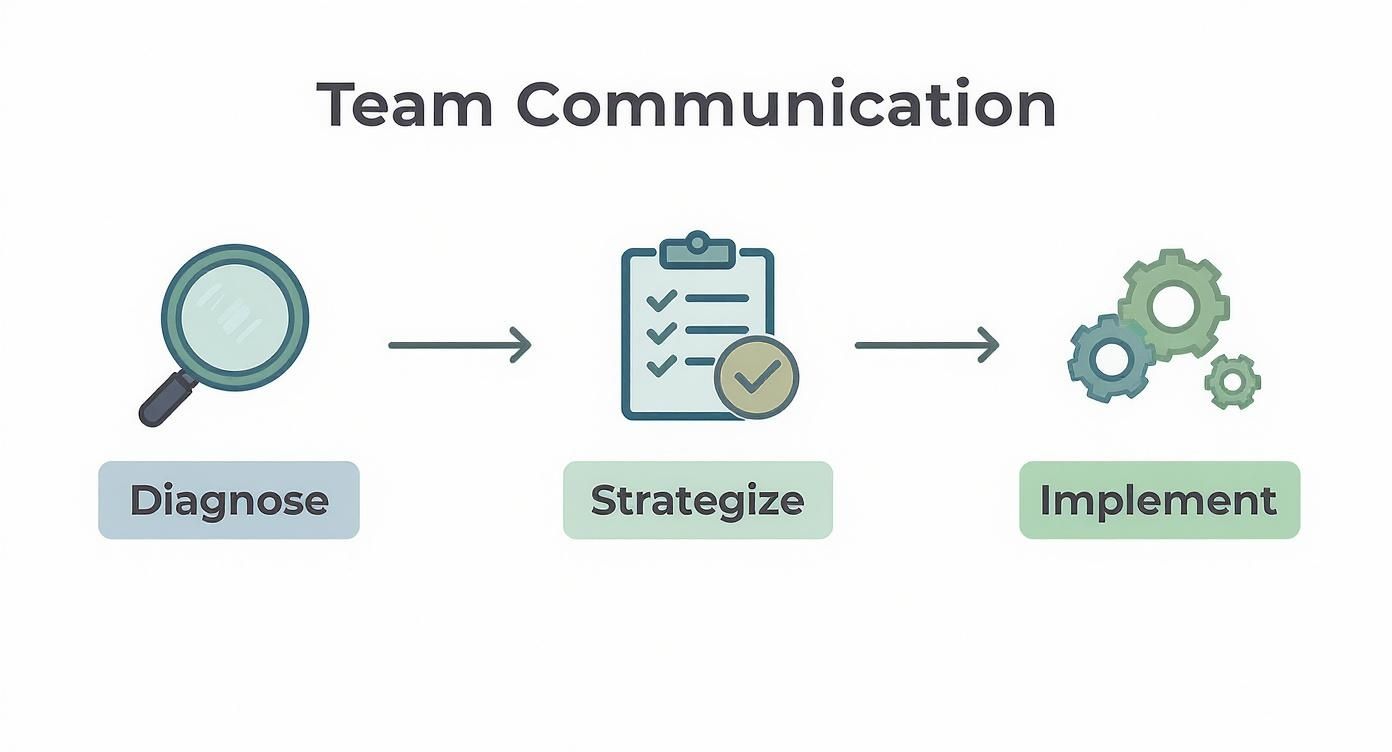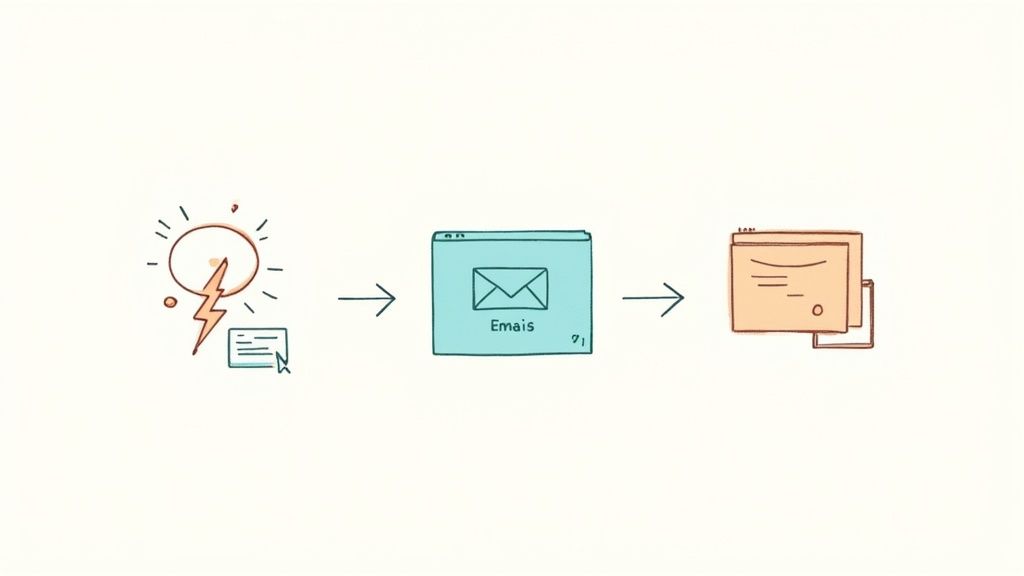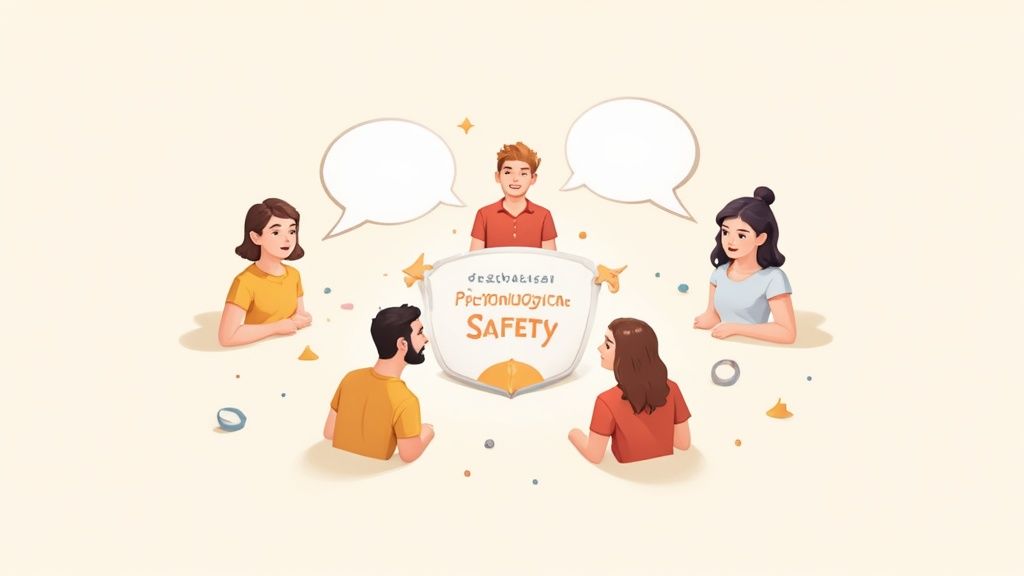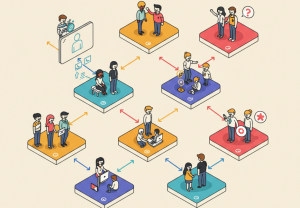We all know the old saying, “communication is key.” But let’s be honest, that phrase has been repeated so often it’s lost all its meaning. The reality is, poor communication isn’t just a minor annoyance; it’s a silent killer of productivity, morale, and ultimately, your bottom line.
Table of Contents
It’s the endless rework because the brief wasn’t clear. It’s the missed deadlines because two people thought the other was handling it. It’s that sinking feeling of disengagement when nobody seems to be on the same page. Fixing this isn’t about adding another “soft skill” to the list—it’s a fundamental business necessity.
The True Cost of Poor Team Communication
The link between how well a team talks and how much they get done is incredibly direct. Consider this: teams that have their communication dialed in can experience a productivity increase of up to 25%. That’s not a small number.
It’s no surprise that 64% of business leaders point to effective communication as a primary driver of team productivity. If you’re interested in the data behind this, you can dig into the full research on team communication statistics.
A Roadmap for Lasting Improvement
So, where do you even start? Moving from communication chaos to true clarity doesn’t happen by accident. It requires a deliberate plan. This guide serves as your playbook for completely overhauling how your team connects and collaborates, from identifying what’s broken to building habits that stick.
This entire process can be broken down into several core stages.

As you can see, it’s a straightforward but powerful approach. You start by diagnosing the real problems, then build a strategy to fix them, and finally, put the tools and new routines into practice.
A huge piece of this puzzle is creating a culture of recognition. People won’t speak up, share risky ideas, or give honest feedback if they don’t feel psychologically safe. And that safety is built on a foundation of feeling seen and valued. Recognition is important because it reinforces the specific behaviors you want to see more of, like proactive communication or cross-team collaboration. It shows people that their contributions are not just noticed, but are actively helping the team succeed.
It doesn’t have to be complicated. For a practical example, when a manager gives a public shout-out to a junior employee for asking a great question in a team meeting, it sends a powerful message to everyone else: your voice matters here. That single action can help turn a room full of passive listeners into a team of active, engaged contributors.
If you’re looking for some immediate actions you can take, this table breaks down a few high-impact strategies.
Quick Wins for Better Team Communication
| Strategy | Core Benefit | Example Action |
|---|---|---|
| Establish Channel Guidelines | Reduces noise and confusion | Create a simple chart: “Use Slack for quick questions, Email for formal updates, Asana for task-specific comments.” |
| Implement Daily Stand-ups | Creates alignment and surfaces blockers | Run a 15-minute meeting each morning where everyone shares what they did yesterday, what they’ll do today, and any roadblocks. |
| Start a “Kudos” Channel | Boosts morale and psychological safety | Make a dedicated #kudos or #wins channel in Slack for peer-to-peer recognition. |
| Use Meeting Agendas | Makes meetings more focused and productive | Require a clear agenda with desired outcomes for every meeting invitation sent. No agenda, no meeting. |
These small changes might seem simple, but they create the structure and positive reinforcement needed for great communication to become the default, not the exception.
Finding the Gaps in Your Communication
Before you can build a better system, you need an honest look at what’s actually broken. It’s easy to say “our communication is bad,” but that doesn’t get you anywhere. The real goal is to move past that general frustration and pinpoint the specific problems.
Maybe project updates are a mess and nobody knows who’s doing what. Or perhaps people are just plain hesitant to speak up and offer a different opinion. These are the kinds of issues that create friction, slow things down, and cause misunderstandings. They’re often hiding in plain sight—in how we run meetings, share information, or even in the unwritten rules about who talks to whom.
Start with a Communication Audit
Think of yourself as a detective. Your first move is to conduct a communication audit to gather clues about where things are falling apart. This doesn’t need to be some massive, formal undertaking. The primary goal is to obtain honest, unfiltered feedback from your team.
Here are a few practical ways to get started:
- Anonymous Surveys: This is often the best way to get candid feedback. People are much more likely to be honest when they don’t have to attach their name to a criticism. A simple Google Form is all you need.
- One-on-One ‘Listening Tours’: Set aside 15-20 minutes for an informal chat with each person on your team. The key is to frame it as a listening session about their experience, not an interrogation looking for someone to blame.
- Observe Team Meetings: Pay attention to the dynamics in your next few meetings. Who does most of the talking? Are people genuinely engaged, or are they multitasking on another screen? Crucially, does everyone walk away with clear action items?
By using a combination of these methods, you obtain a much richer understanding of the problem. You’ll have hard data from the surveys alongside the nuanced stories you hear in your one-on-ones.
Pro Tip: You can’t solve a problem you don’t fully understand. Taking the time to diagnose the real issues stops you from rolling out “solutions” that don’t actually fix anything.
Asking the Right Questions
The success of your audit hinges entirely on the questions you ask. Vague questions will get you vague, unhelpful answers. You need to zero in on specific scenarios and behaviors to uncover the real gaps.
This is especially true for remote or distributed teams. When you have people scattered across the country (or the world), just figuring out when to meet can be a huge source of friction. Using an effective meeting planner for time zones is a simple but powerful tool to solve that specific pain point.
Here are a few questions I’ve found useful:
Sample Survey Questions (Scale of 1-5, Strongly Disagree to Strongly Agree):
- How clear are you on your top 3 priorities for this week?
- Do you feel you have all the information you need to do your job well?
- How comfortable do you feel giving honest, constructive feedback to a colleague?
- Our team meetings are a valuable use of my time.
One-on-One Discussion Prompts:
- “Can you walk me through a recent time you felt out of the loop on a project?”
- “If you have an urgent question, who or what is your first stop for an answer?”
- “What’s one thing we could change about our team meetings that would immediately make them better for you?”
Once you’ve gathered all this feedback, you’ll have more than just a vague feeling. You’ll have a clear, actionable list of problems ready to be solved. This is the foundation for building a communication strategy that actually works.
Building a Clear Communication Operating System

Great team communication doesn’t just happen by accident. It’s designed. When you don’t have a plan, you get chaos—endless email chains, important Slack messages getting buried, and constant shoulder taps that kill any chance of deep work.
The answer is to build a communication “operating system.” Think of it as a set of shared rules of the road that brings some much-needed predictability to how your team talks to each other. It takes the guesswork out of simple but critical questions, like “Should this be an email or a Slack?” or “How fast do I need to reply to this?” Creating an intentional framework cuts through the noise and helps everyone get the information they need without feeling totally overwhelmed.
Define Your Communication Channels
First things first: give every tool a job. When each channel has a clear, agreed-upon purpose, people naturally start using them more effectively. This one move can radically improve information flow by making sure the right messages land in the right place.
Here’s a simple, real-world example of what this looks like in practice:
- Slack/Microsoft Teams: This is for the urgent stuff. Think of time-sensitive questions and quick-fire updates that require a fast response, such as, “Is the server down for anyone else?” or “Can someone review this pull request before EOD?”
- Project Management Tool (Asana, Jira, Trello): All communication about a specific task lives here. This includes status updates, feedback on a design, or questions about a blocker. No exceptions.
- Email: Keep this for more formal, official business. Think of company-wide announcements or anything that will be shared with external parties, such as clients and partners.
- Video Calls (Zoom, Google Meet): Reserve these for the conversations that need a human touch. Complex problem-solving, big-picture strategy talks, and 1-on-1s all benefit from seeing faces and reading body language.
This simple structure prevents a critical project update from getting lost in a sea of GIFs and keeps everyone’s inbox from turning into a casual chat room. If you want to go deeper, exploring various strategies to improve team communication can offer some great additional frameworks.
The goal isn’t to add more bureaucracy. It’s about creating more clarity. A well-defined system empowers your team by making it obvious where to find information and where to share it.
Establish Communication Norms and Etiquette
Once your channels are defined, the next step is to agree on how you’ll use them. These are the “rules of engagement” that cover everything from expected response times to what makes a good meeting. Getting everyone aligned on these basics is how you truly improve team communication.
A fantastic way to make this stick is by creating a Team Communication Charter. This should be a living document that you build with your team, not for them. It’s your shared agreement.
Your charter could include simple guidelines like:
- Response Times: We’ll acknowledge non-urgent Slack messages within 4 hours and emails within 24 hours.
- Meeting Etiquette: Every meeting must have an agenda and a clear goal sent out beforehand. No agenda, no meeting.
- Status Updates: Everyone posts a quick, asynchronous daily update in their project channel by 10 AM their local time.
Let’s be honest, digital tools are here to stay and are only getting more complex. A recent study found that 73% of knowledge workers who use generative AI report it has helped them avoid miscommunication at work. With 89% of leaders and 52% of employees already using these tools, it’s clear we need human-led guidelines to make sure our tech actually helps us connect, not create more confusion.
Build a Foundation of Psychological Safety and Great Feedback

You can have the slickest tools and the most documented processes in the world, but if your team doesn’t trust each other, communication will inevitably break down. That trust is built on a foundation of psychological safety—a shared belief that the team is a safe place for taking risks.
It’s the feeling that you can float a half-baked idea, ask a “dumb” question, or admit you messed up without being shot down or shamed.
When people feel safe, they stop worrying about how they look and start focusing on solving problems. This is where real innovation comes from. It’s what separates a team that just nods along with the boss from one that challenges ideas to make them truly great.
It Starts with Leaders Modeling Vulnerability
Creating this kind of environment has to start at the top. When managers openly admit they don’t have all the answers or share a story about a past mistake, it sends a powerful signal. It tells the whole team it’s okay to be human.
For a practical example, a manager could kick off a project by saying, “Heads up, on the last launch, I totally underestimated our QA timeline and it created a mad scramble. This time, let’s be realistic and build in a bigger buffer from the start.” This reframes failure as a group learning opportunity, not a personal indictment.
Psychological safety isn’t about being fluffy or avoiding tough conversations. It’s about building a culture of respect where people feel safe enough to be candid, knowing their voice actually matters.
Formalizing feedback is also a huge piece of the puzzle. Don’t wait for the dreaded annual review. Instead, build in regular, low-stakes moments for the team to reflect. I’m a big fan of the “Start, Stop, Continue” retrospective:
- Start: What’s one thing we should start doing?
- Stop: What’s one thing that’s getting in our way and we should stop doing?
- Continue: What’s working well that we should absolutely continue doing?
This simple framework depersonalizes feedback and shifts the focus to improving the system, which is a game-changer for team communication.
Don’t Underestimate Consistent Team Recognition
One of the most powerful—and often overlooked—ways to build psychological safety is through consistent, authentic recognition. When people feel seen and valued for what they do, their sense of belonging and confidence goes through the roof. The importance of team recognition lies in its ability to directly reinforce the exact behaviors you want more of, especially great communication. It’s a simple, positive feedback loop: you recognize good work, and you get more of it.
But for recognition to actually work, it can’t be a rare, top-down proclamation. It needs to be frequent, specific, and woven into the fabric of peer interactions. A generic “good job, team” is nice, but it doesn’t land with any real impact.
Specific praise, on the other hand, is a powerful teaching tool. Instead of “thanks,” try a practical example like: “Shout-out to Sarah for catching that gnarly bug right before the release. Your attention to detail just saved us from a weekend of firefighting.” Now everyone sees exactly what a valuable contribution looks like. If you’re looking for inspiration, there are tons of great positive feedback examples you can steal and adapt.
Make Recognition a Daily Habit
The real magic happens when recognition becomes a daily reflex, not a special occasion. And you don’t need a huge budget or a complex program to make it happen.
One of the easiest wins is to create a dedicated #kudos or #wins channel in Slack. It creates a public space where anyone can celebrate a teammate at any time.
Another killer practice is to dedicate the first five minutes of your weekly team meeting to sharing “wins and appreciations.” This small ritual turns recognition into a reliable part of your team’s rhythm, constantly reinforcing a culture of gratitude and open communication.
Turn Team Rituals Into Your Secret Weapon for Stronger Bonds
A one-off team-building event is great for a day, but it’s the consistent, everyday rituals that truly forge strong team connections. Think of these as the connective tissue of your team’s culture. They’re small, predictable moments woven into your workweek that build the trust needed for real, open communication.
It’s just like building a friendship. You don’t become best friends after one big party; it’s the regular check-ins and shared experiences that deepen the bond. The same logic applies directly to your team.
Making Your Meetings Actually Matter
Your team already has meetings on the calendar—stand-ups, weekly syncs, you name it. The trick is to infuse these existing touchpoints with moments that build community, not just tick off agenda items. This is a game-changer, especially for remote teams who miss out on all those spontaneous “water cooler” moments.
A simple but incredibly effective habit is to kick off every meeting with a quick, non-work check-in. It could be a classic “rose and thorn” (sharing one good thing and one challenge) or something lighthearted like, “What’s the best thing you ate this week?” This small gesture immediately signals that everyone is seen as a person first, and a colleague second.
Designing Your Team’s Unique Rhythm
For these rituals to become second nature, they need a predictable rhythm. This consistency creates a sense of stability and gives people something to look forward to. The idea is to create a cadence that builds connection without jamming everyone’s calendar with more meetings.
Here are a few practical ideas you can steal and adapt:
- Daily Stand-ups: Keep them tight and focused, but always carve out 60 seconds for a personal check-in. It’s amazing what you learn about what might be affecting someone’s day.
- Weekly Tactical Meetings: Start with a five-minute “wins and appreciations” round. This bakes recognition right into your team’s operating system.
- Monthly Strategic Check-ins: Block off a small part of this meeting for something fun and totally unrelated to work. For distributed teams, finding some genuinely fun virtual team building activities can be a fantastic way to break the monotony and just enjoy each other’s company.
When you make connection a routine, it stops being an afterthought. It becomes an essential, expected part of how you operate as a team.
This consistent investment in your team’s relationships pays off in a huge way. A Gallup survey found that companies that prioritize open communication and team-building see a 14% boost in performance and up to a 23% jump in profits. These rituals aren’t just feel-good exercises; they are a direct line to better business results.
Got Questions About Team Communication? We’ve Got Answers.
Even with a solid plan, you’re bound to hit a few snags or have questions pop up. That’s totally normal. Getting ahead of these common challenges means you can solve them before they slow your team down.
Let’s dig into some of the questions I hear most often from managers trying to get this right.
What’s the Single Most Important Thing I Can Do First?
If you do only one thing, create a Communication Charter. Seriously. This is the bedrock of good communication.
Think of it as your team’s rulebook. It’s a simple document that spells out which tool to use for what, what the expectations are for response times, and the basic ground rules for meetings. It takes the guesswork out of everything.
For a practical example, your charter might say, “Urgent questions go in Slack. All project updates and feedback must happen in Asana to keep everything in one place.” Just that one rule can slash the amount of noise and confusion your team deals with every day.
How Do I Get My Quieter Team Members to Speak Up?
This is a big one. The key is realizing that not everyone is comfortable thinking out loud in a high-pressure meeting. To draw out those valuable insights, you need to offer different ways for people to contribute.
Here are a few things that have worked for me:
- Try a round-robin. Don’t just leave the floor open. Go around the virtual room and specifically ask each person for their take. It signals that every single voice is not just welcome, but expected.
- Use async channels to your advantage. Post a big question in a shared doc or a dedicated Slack channel a day before the meeting. This gives your more deliberate thinkers the space to process and write down their thoughts without being put on the spot.
- Acknowledge their input. When a quieter person does share an idea, make a point to validate it. A simple, “That’s a really sharp insight, Sarah, thanks for sharing that,” goes a long way in building their confidence.
Don’t underestimate the power of recognition here. When you publicly praise a thoughtful comment from someone who doesn’t speak up often, you’re sending a message to the whole team: we value all contributions, not just the loudest ones. Recognition is important because it shows you value different communication styles and creates a safer space for everyone to participate.
How Can I Tell if Our Communication Is Actually Getting Better?
You’ll want to look at both the hard numbers and the team’s vibe.
On the quantitative side, you can track operational metrics. Are you seeing less time wasted on rework? Are projects finishing faster? Are there fewer “just clarifying” emails flying around? These are concrete signs that information is flowing more efficiently.
For the qualitative side, you can’t beat short, regular pulse surveys. Ask your team to rate things like psychological safety, goal clarity, and how effective they feel meetings are on a scale of 1-10. When you see those scores trending up over a quarter and hear positive feedback in your one-on-ones, you know you’re on the right track.
What if My Team Pushes Back on New Tools or Processes?
Resistance is usually a symptom of something else. It’s often not about the tool itself, but about the team not understanding why a change is needed or feeling like it’s just one more thing on their plate.
To get everyone on board, you have to connect the change to a real pain point they’re already feeling.
Instead of just rolling out a new tool, frame it as the solution they’ve been asking for. For a practical example: “I know we’ve all felt drained by back-to-back meetings. We’re going to try out this new process with the goal of cutting our internal meetings by 20%, which should give everyone more deep-work time.”
Even better, involve them in picking the tool or tweaking the process. When people feel a sense of ownership, they’re far more likely to embrace it. And, of course, you have to lead by example. Use the new tools consistently and give shout-outs to others who are doing the same.
Ready to make recognition a seamless, daily habit? AsanteBot seamlessly integrates with Slack, transforming appreciation into a fun and measurable ritual that strengthens your team’s communication and culture. Start building a more connected team today.




